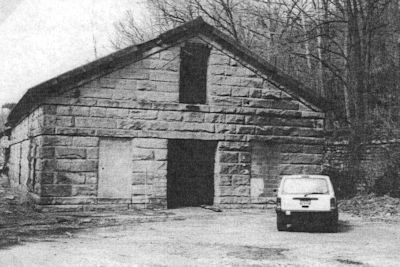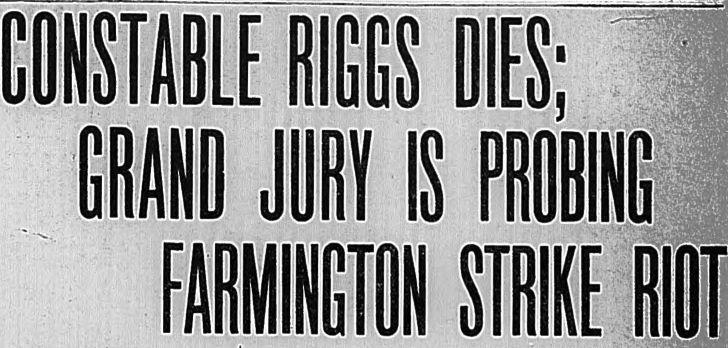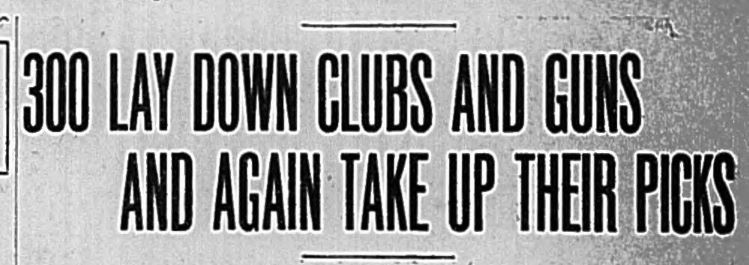
It was a day like any other day. The men rose and prepared to go to work. The last few days’ works seemed to have had a heavy tension in the air, and it felt like a powder keg ready to blow. Would today be the day? Would they work, or would they walk?
It was Febuary 16, 1915. The immigrants who had been working for Jamison Coal and Coke Co. had come to their breaking point. No advancement, no matter how hard they worked. No pay raises. The conditions are always the same. Injuries and deaths. A common occurrence in the mine life.
So the strike was the answer. The first walk-out came from the #8 mine in Farmington, then #9 at James Fork, and lastly, #7 at Barrackville. The leaders for the strike and where the orders came from arose at Farmington. They marched under the banners of the American flag, which was mounted above a red flag and atop a banner that read “United We Stand; Divided we Fall, Give Us Justice or Nothing at All.”
How had it come to this point? What was the straw that had broken the camel’s back? It was explosives. The company felt the miners used too much to shoot the coal from the face. With the company footing the bill for the powder, how could they make the miners more responsible with its use? The answer would infuriate the men.
Jamison said that using too much powder by unskilled or careless miners reduced the coal’s value by breaking valuable lumps into fine dust or slack. Their solution was to charge “The Shooter” [the person that sets and detonates the explosives] one dollar for 15 charges and blasting caps.
Jamison figured that one dollar of charges should fill 25 cars with coal. Doing it this way would save the company, and miners would become more careful. Jamison said in order that the miners would not feel cheated; they would now give the miners a raise to 4 cents more a car.
Miners took it as a way to disguise a wage cut and walked out. They may have had the reasons for the strike, but with no union, they had no knowledge of how to run it at the time. Even the United Mine Workers Of America would back off, afraid of the mighty coal barons of Fairmont.
Jamison refused even to negotiate with the strikers. The three mines combined employed over 1000 men. Three to six hundred men took to the road.
As soon as the walk-out happened, Jamison hired 25 private detectives from the F. W. Muncy Detective Agency out of Pittsburgh. Their job was to protect the company’s property and break the strike. This just added fuel.
In Marion County, the leaders did not uphold the use of the red flag the strikers flew. The meaning of its use was thought to be the “emblem of collectivism and working-class struggle against capitalism.”
With the fear of the strike spreading to other mines, citizens also felt fear of public order and private property. The strikers would uphole this fear by carrying Hickory clubs or pick-axe handles studded with lethal spikes or iron bolts.
After the fourth day of the strike, Jamison went to the sheriff, C.D. Conaway, and claimed a striker had thrown a rock and broken a window in the office, and another striker had beaten up a miner trying to return to work.
The next day Conaway and a band of 12 armed county officers, including one with the name of William Ross Riggs, headed to the Farmington mine with warrants in hand.
Constable Riggs started working at a very early age due to his father’s death from a gunshot wound inflicted while doing his job.
He started out his career as a conductor on the B&O Railroad in Wheeling, W.V., then progressed to yardmaster. He did this for 17 years. He felt he needed a new career and moved to Fairmont, and was elected to be a constable. He would hold this job for 14 years. Prohibition was flickering at this time. Constable Riggs took up the cause.
When Sheriif Conaway and his posse arrived at the mine and saw a large number of strikers, he got worried. Boos and insults flew everywhere, and explaining why he had these warrants would not go over lightly. Riggs volunteered to make the arrests. Conaway said no, they would all go in among the strikers and find the troublemakers. The Sheriff wanted to make it clear who had the power. Two arrests were made, and as they turned to leave, they found themselves between two sets of angry strikers. One of the prisoners held onto by Constable Kerns squirmed free and the strikers encircled Kerns and struck him senseless. The other prisoner tried to free himself from Riggs, and because of what happened to Kerns, the Sheriff fired shots into the air.
The atmosphere changed quickly. The strikers overtook the sheriff and his men and were beaten badly. Conaway and his men lost their weapons in the tussle and ran to the company store. Riggs still holding on to his prisoner, went there also. Riggs had just about made it when his man freed himself and ran.
Most of the strikers knew Constable Riggs because he was always taking them to jail for drinking, he was a hated man, to begin with. The miners now grabbed a hold of Riggs and began to beat him unmercifully. There was no help to be found.
Constable Riggs was able to get free of the mob, and stumbling and bleeding badly, he made it to a farmhouse on the hill. The farmers there placed him on a bed and bandaged his swollen, bleeding head.
Sheriff Conway and his men were also beaten badly, and the detectives Jamison hired were no help. The constables and sheriff found a hole and escaped to safety.
Word was sent to bring Constable Riggs to town. He had lost conscientious and would remain that way for ten days.
He was taken to Cook hospital, and after a few operations to relieve the pressure on his brain, at five o clock, ten days later, Constable Riggs died. He never regained conscientious.

A coroner’s inquest would swiftly follow. The coroner Frank Lloyd and the members of the jury would witness the autopsy done by Dr. Darrett. He would show the exact causes of Riggs’s death. His skull had obtained two large fractures on each side of his head. It was found his brain was bloodshot. Throughout, the tissue was broken down and dissolved as a result of the blows.
Many of the strikers fled the county when the news was broadcasted about Riggs’s death. They were sure they would be arrested. One Hundred and Thirty-Four warrants were issued for murder.
Some came in peacefully and others had to be caught and brought back by special deputies. Some miners made it as far as Boston, Chicago, and Detroit.
These men’s houses were searched: stilettos, knives, revolvers, and many clubs were found. In one house was found a broken club that contained human hair and tissue. This was proven to be the club that hit Constable Riggs and killed him. The Italian miner who lived at this residence had hit him so hard the second time it broke the club in two.
The man found guilty of his death got life in prison. There were four other miners found guilty of assault with deadly weapons. They each received four years in prison.
The court proceedings were over. It was time now to have Constable William Riggs funeral.
It was estimated that around 25,000 mourners attended the service held at First Presbyterian Church on Jackson Street in Fairmont, W.V. Three ministers would preach at his service. Many eulogies were read from patrons, describing him as a “Faithfull, conscientious, and fearless hero.”
It was February 24, 1915, when he passed, and after eleven days of waiting, on a cloudless winter afternoon, Constable William Ross Riggs was laid to rest at Woodlawn Cemetery in Fairmont. He would be high on the hill keeping watch over the town he loved.
After this, the Jamison Coal and Coke Company would resume work at all mines. I’m unsure if conditions ever got any better then, but life continued.

I will publish a new weekly blog containing more Fairmont and Marion County history. If there is a topic you may want to explore more, please comment below, and I will research it. Please comment below, letting me know if you did or didn’t like this article. It helps me improve with your suggestions.
Thank you for taking the time to read my blog, and remember: History is the spine of America; not learning from it would make us collapse and fall!
I
